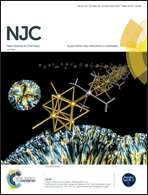Rare, hypodentate L-κS coordination mode of N,N-dialkyl-N′-aroylthioureas leads to unprecedented mixed-ligand [Pt(phen)(L-κS)2] complexes†
Abstract
Novel, uncharged mixed-ligand [Pt(1,10-phenanthroline)(Ln-κS)2] (n = 1, 2) complexes have been isolated, in which two usually chelating N,N-dibutyl-N′-1-naphthoyl-thioureato (L1)−, or N,N-diethyl-N′-benzoyl-thioureato (L2)− anions coordinate to Pt(phen)Cl2 in an unprecedented κS-thio/amido mode of coordination. These previously unidentified compounds, are undesirable by-products in the synthesis of the biologically active mixed-ligand [Pt(diimine)(L-κO,S)]+X− complex salts, in which the well-documented tendency of such HLn ligands to coordinate in a bidentate (L-κO,S) mode of coordination is exploited. In the case of the N,N-dibutyl-N′-1-naphthoyl-thioureato, the [Pt(phen)(L1-κS)2] complex is the dominant product obtained in highest yield. Single-crystal X-ray diffraction analysis of [Pt(phen)(L1-κS)2] indicates significant intramolecular π–cation type stacking interactions that appear to stabilize these hypo-dentate (L-κS)− modes of coordination. Significantly, 1D-NOE NMR spectroscopy shows that for the [Pt(phen)(L1-κS)2] complex, the intra-molecular π-stacking interactions between the naphthyl and Pt(phen) groups certainly persists in methanol solutions, at room temperature. By contrast, in the N,N-diethyl-N′-benzoyl-thioureato analogue of [Pt(phen)(L2-κS)2], inter-molecular head-to-head, stacking interactions between the Pt(phen) moieties of adjacent independent molecules dominate the in the solid-state structure of this complex. Significantly, use of a non-aromatic N,N-diethyl-N′-pivaloylthiourea (HL3) results in the formation of only low yields (<10%) of the corresponding [Pt(phen)(L3-κS)2] using identical preparative methods; moreover, [Pt(phen)(L3-κS)2] could not be isolated as it is unstable on workup.
![Graphical abstract: Rare, hypodentate L-κS coordination mode of N,N-dialkyl-N′-aroylthioureas leads to unprecedented mixed-ligand [Pt(phen)(L-κS)2] complexes](/en/Image/Get?imageInfo.ImageType=GA&imageInfo.ImageIdentifier.ManuscriptID=C7NJ03178E&imageInfo.ImageIdentifier.Year=2017)


 Please wait while we load your content...
Please wait while we load your content...